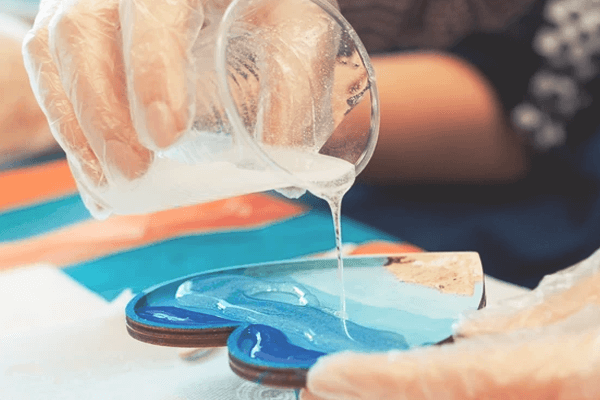If enough time has passed and epoxy resin hasn’t hardened yet, it’s because the resin is still not cured. And there you ask, “What to do if Epoxy doesn’t Harden?” However, in these kinds of situations, the obvious questions should be: what went wrong and what should be done about it?
To know about what went wrong, the first order of business is to know: how it goes right. Ideally two chemicals epoxy and resin are mixed and left so that the chemical reaction can occur. In time these two form bonds and transition from a liquid state to a solid one.
Two issues are critical to making it happen: correct proportion (ratio) and enough time.

Contents
Reasons why epoxy doesn’t harden?
Malfunction, when it comes to epoxy resin hardening can occur from three primary reasons:
Low Ambient Temperature
Ideally, the room temperature of the workplace should be maintained between 24 to 30-degree Celsius (that is 75 to 84-degree Fahrenheit). This is particularly important during the early hours of the reaction. Especially during the first 24 hours, this temperature range should be maintained. Otherwise, the mixture will remain sticky.
Incorrect Ratio
The ratio between raisin to hardener needs to be accurate. It may vary from product to product. But generally, it is 1:1 or 2:1. Not being able to maintain the strict proportion of the two inevitably hinders the chemical reaction. Too much hardener in epoxy resin or too little of it will certainly ruin the process. Exact specifications are mentioned on the packaging of the product.
Inadequate Mixing Process
If the mixing process isn’t thorough, the chemicals won’t be able to collude to form proper bonding. Unlike most low viscosity liquids, resin and hardeners don’t automatically defuse through each other due to their natural diffusivity. Partly formed bondings further hamper natural diffusion. At least a 3-minute mixing is needed to get the process thoroughly done.
Wrong Measurement
Resin and hardener are formulated to be measured volumetrically. Often instead of measuring in terms of volume, they are measured in terms of weight. This inevitably leads to the second point, incorrect ratio.
Wrong Ingredients
In order for the reaction to take place, the resin should be mixed with the hardener and vice versa. However bizarre may it sound, sometimes the users mix up resin with resin or hardener with hardener! Naturally, this mistake overrules the whole process. The reaction cannot take place, to begin with.
Excessive Amount of Colorant
Resin colorant is to be injected at an optimal ratio in order to get the desired effect. Colorant, if too much of it is used, can act as a negative catalyst. Maximum 6 percent coolant may be used. That is in a 100ml resin-hardener mixture, the highest limit of colorant that can be added is 6ml.
Scraping the Side of the Mixture-container:
It is generally advised to scrape the sides of the mixture container when mixing the two ingredients. However, when it comes to pouring, it is recommended not to scrape the sides. Because even an otherwise good mixing may have less than adequately mixed portions at the edges. These portions often get into the pour due to benign scraping, which results in soft sports in the resin.
What to do if Epoxy doesn’t Harden?
Care should be taken to avoid the Not-Hardening problem altogether. Just in case it does happen, it should be figured out, what exactly happened. Generally, one of three phenomena can arise: sticky resin, runny resin and soft spots.
Phenomenon 1 – Sticky Resin
Sticky resin is easily detectable as the surface feels like the sticky side of a tape. This occurs when the resin, in its microstructure, has already been solidified; so it cannot be molded any longer. To fix it:
- It should be dried for 24 more hours by placing it in a location that is warmer than the original workplace. The problem might be resolved by just doing this!
- If the stickiness still persists, then a sanding can be attempted. 80-grit sandpaper, whether wet or dry, can get the job done.
- The sticky substance should be sand-scraped till the evenly solid surface underneath it is uncovered.
- Alternatively, the uneven and sticky surface can be simply sealed off. Both resin-based ones and acrylic sealers are applicable.
- Without going through all these hurdles – if there are no soft spots or runny resin – pouring a freshly mixed and properly calibrated raisin-hardener mixture can be considered. Once it cures properly, the sticky problem will be no more.
Phenomenon 2 – Soft Spots
Soft spots are randomly distributed spots of unsolidified resin. Most of the surface may be cured but it is riddled with wet spots of uncured resin. It happens due to proper mixtures getting mixed with improper portions from the side of the mixing pot. To fix it:
- The solidified or cured portions of the surface should be sanded off. 80-grit sandpaper can be used for this job.
- Once the cured surface is sanded, the sanding dust should be whipped clean using a mildly damp cloth.
- The gooey or runny resin should also be completely removed. If not this may spill out later, through the new resin layer that is to be coated later.
- Once the surface is prepared, a properly mixed new pour should be applied.
- This new layer should be left for 24 hours to be completely cured. If done properly, this surface will bear no mark of the soft spots.
Phenomenon 3 – Runny Resin
It is the most obvious type to spot: gooey and wet resin spread across the entire surface without any clearly solidified portion. In this case, the resin-hardener mixture is somewhat close to the cured state, but not quite. To fix it:
- If possible the entirety of gooey material should be scraped off. At least as much as possible.
- Serious concern should be put to scrape the wet resin off. Because otherwise, the wet and uncured resin may leak out from underneath the new coating of raisin.
- As the entire resin surface is unmodified, no sanding will be needed.
- Once the runny resin is cleaned off, a freshly mixed and accurately measured resin-hardener mixture is to be poured onto the surface. Eventually, the new layer should be left to be cured.
You may like
FAQs
Still have some questions in mind? Have a look at the section below.
Why is my epoxy resin still soft?
Either there’s too much hardener in epoxy resin or simply not enough hardener in epoxy resin. If you’re new to this, it can also be the case that you’ve mixed up hardener with hardener or resin with resin!
Or maybe the temperature isn’t right. Remember, the ambient temperature should be high enough to facilitate a complete exothermic reaction and form strong bondings.
It can also happen if the resin is too old. In that case, the chemical properties may deteriorate.
Retainment of moisture can also lead to the softness of epoxy resin.
Will epoxy harden with too little hardener?
It depends on what your definition of too little is. Ideally, 1:1 is the resin to hardener ratio. If the ratio tilts, either way, it will lead to malfunctions. If the amount of hardener is too low it’ll lead to a soft layer.
Our advice will be to scrape off the runny layer of wet resin and replace it with a proper coating. If you don’t remove the liquid resin completely, it may leak out and ruin your new coating as well!
Why is my resin still sticky?
If your epoxy resin layer is still sticky even after a 24-hour curing period, probably the workplace temperature (ambient temperature of the workplace) is too low to facilitate a proper curing reaction. The length of the curing period may vary from resin to resin, so keep it in mind.
It can also be due to an improper ratio of resin and hardener. Generally, the ratio is 1:1. In some cases, it can be 2:1 as well.
Too much colorant mixed in the resin-hardener mixture can also lead to a sticky mixture. The maximum amount of colorant that can be injected into the mix is, generally speaking, 6%.
Conclusion
If you came this far, you know exactly what can prevent your epoxy from hardening. Or what just happened to your epoxy coating! Don’t put on a long face, it happens from time to time! At least you know exactly how to fix resin that didn’t cure.
Follow our instructions. It will help you to diagnose and hopefully correct all your mistakes. And you’ll find yourself with a sparklingly beautiful and glossy finish. All because you know what to do if epoxy doesn’t harden. That being said Good luck. Say your worries goodbye.
